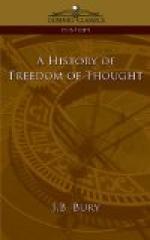The Revolution began well, but the spirit of Mirabeau was not in the ascendant throughout its course. The vicissitudes in religious policy from 1789 to 1801 have a particular interest, because they show that the principle of liberty of conscience was far from possessing the minds of the men who were proud of abolishing the intolerance of the government which they had overthrown. The State Church was reorganized by the Civil Constitution of the Clergy (1790), by which French citizens were forbidden to acknowledge the authority of the Pope and
[113] the appointment of Bishops was transferred to the Electors of the Departments, so that the commanding influence passed from the Crown to the nation. Doctrine and worship were not touched. Under the democratic Republic which succeeded the fall of the monarchy (1792-5) this Constitution was maintained, but a movement to dechristianize France was inaugurated, and the Commune of Paris ordered the churches of all religions to be closed. The worship of Reason, with rites modelled on the Catholic, was organized in Paris and the provinces. The government, violently anti-Catholic, did not care to use force against the prevalent faith; direct persecution would have weakened the national defence and scandalized Europe. They naively hoped that the superstition would disappear by degrees. Robespierre declared against the policy of unchristianizing France, and when he had the power (April, 1795), he established as a State religion the worship of the Supreme Being. “The French people recognizes the existence of the Supreme Being and the immortality of the Soul”; the liberty of other cults was maintained. Thus, for a few months, Rousseau’s idea was more or less realized. It meant intolerance. Atheism was regarded as a vice, and “all were atheists who did not think like Robespierre.”
[114]
The democratic was succeeded by the middle-class Republic (1795-9), and the policy of its government was to hinder the preponderance of any one religious group; to hold the balance among all the creeds, but with a certain partiality against the strongest, the Catholic, which threatened, as was thought, to destroy the others or even the Republic. The plan was to favour the growth of new rationalistic cults, and to undermine revealed religion by a secular system of education. Accordingly the Church was separated from the State by the Constitution of 1795, which affirmed the liberty of all worship and withdrew from the Catholic clergy the salaries which the State had hitherto paid. The elementary schools were laicized. The Declaration of Rights, the articles of the Constitution, and republican morality were taught instead of religion. An enthusiast declared that “the religion of Socrates, Marcus Aurelius, and Cicero would soon be the religion of the world.”
A new rationalistic religion was introduced under the name of Theophilanthropy. It was the “natural religion” of the philosophers and poets of the century, of Voltaire and the English deists—not the purified Christianity of Rousseau, but anterior and superior to Christianity. Its doctrines, briefly formulated,




